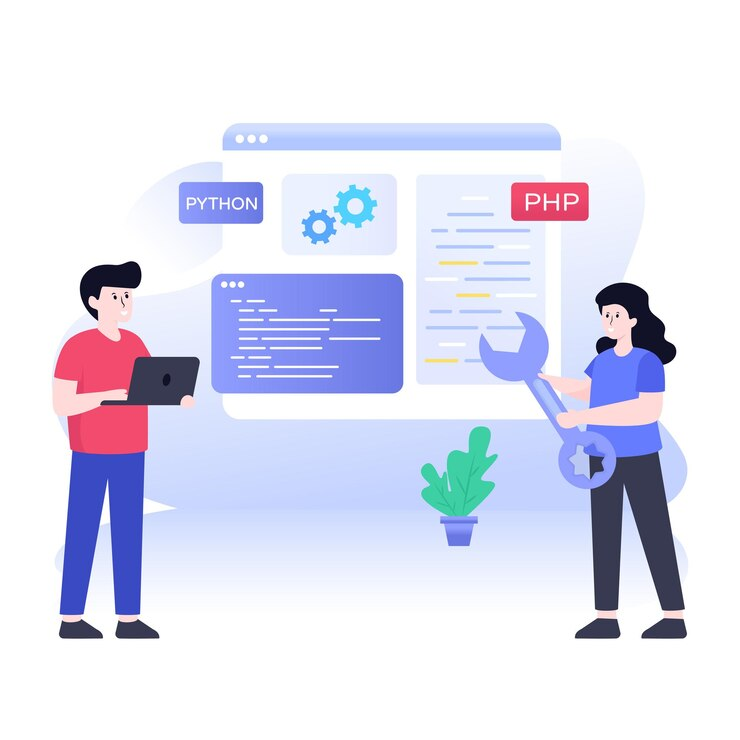In today's technological era, application development is no longer exclusive to professional programmers. No-Code and Low-Code platforms have opened up opportunities for many businesses, especially small and medium-sized enterprises, to build applications themselves without needing to intervene too much in coding. However, despite bringing many benefits such as rapid development speed and cost reduction, these platforms still have certain limitations.
This article will delve into the analysis of the advantages and disadvantages of No-Code and Low-Code technology, while also explaining why comprehensive ERP systems still play a crucial role in managing and developing sustainable businesses. From there, businesses can decide whether to invest in No-Code/Low-Code or ERP for digitalization?
1. General introduction to the No-Code and Low-Code trend

In recent years, the No-Code and Low-Code trends have emerged as innovative solutions that help individuals and organizations build applications without needing extensive programming skills. These platforms help extend software development capabilities to a wider range of users, not just limited to professional programmers. Thanks to this, No-Code and Low-Code have become a strong trend in the technology industry, changing the way software and applications are developed.
- No-Code: These are software development platforms that allow users to create applications without writing a single line of code. Users only need to drag and drop interface components, configure features, and processes through the graphical interface.
- Low-Code: Similar to No-Code, but with more flexibility. Low-Code platforms require less coding compared to traditional software development, but still allow users to write code if necessary to extend more complex features.
2. Why No-Code and Low-Code are becoming popular?
Rapid development speed: No-Code and Low-Code platforms help reduce application development time, thanks to drag-and-drop tools and available templates. Users can build applications in just a few days or weeks instead of taking months as before.
Easy to use: With an intuitive and simple interface, even those without programming experience can easily access and use these platforms. This allows non-specialists, such as sales staff or managers, to create software solutions to meet work needs without relying on a team of programmers.
Reducing initial costs: Not having to invest in a team of professional programmers helps small and medium-sized enterprises save on application development costs. In addition, No-Code and Low-Code platforms also reduce maintenance and software update costs.
Although No-Code and Low-Code bring many significant benefits, can they completely replace complex systems like ERP (Enterprise Resource Planning) or traditional software development solutions? This is the question many businesses are asking when looking for optimal solutions for application development.
Read more: What is ERP?
3. The standout advantages of No-Code and Low-Code

Rapid development speed
One of the biggest advantages of No-Code and Low-Code platforms is the extremely fast application development speed. Users only need to drag and drop interface components and configure features through a visual graphical interface. This helps reduce the time required to build applications, especially when compared to traditional software development, where manual coding is needed for each feature.
- Visual drag-and-drop, no or minimal coding required: These platforms provide drag-and-drop tools that allow users to easily create application interfaces and logic without needing to write code, or only requiring a small amount of code to extend features if necessary.
- Significantly reduce application deployment time: If a complex application can take several months to several years to develop using traditional methods, with No-Code/Low-Code, you can complete the application within a few days or weeks.
Example illustrating the development time of a simple application:
Customer Relationship Management (CRM) application: Traditionally, it can take from 2 to 6 months to develop a CRM system from scratch. However, with a Low-Code platform, you can build a basic CRM application within 2 to 4 weeks without needing much code. On the No-Code platform, it can even be completed in a few days if the requirements are simple.
Easy to use, no advanced programming skills required.
A major strength of No-Code and Low-Code is their ease of use and the fact that they do not require users to have advanced programming skills. This allows individuals without a technology background to still participate in the application development process.
- Expanding application development capabilities for business users (citizen developers): These platforms create opportunities for citizen developers, who are not professional programmers but have business knowledge, to participate in application development. They can build tools and software solutions that meet work needs without the intervention of the IT team.
- Reduce reliance on dedicated IT teams for simple tasks: Previously, companies often had to depend on programmers to address simple technology requests. However, with No-Code/Low-Code, non-IT staff can build and maintain applications for their own needs, freeing up the IT team to focus on more complex tasks.
- Increase autonomy and flexibility for departments: Departments can be more autonomous in creating applications for work without waiting for IT to handle them, while also reducing complex administrative procedures. This helps improve work performance and brings flexibility to the work process.
Example of using No-Code/Low-Code platforms:
A marketing department can easily create a campaign management tool without IT assistance, simply by dragging and dropping necessary components like email templates, registration forms, data analysis tools, etc.
Reduce initial costs
One of the important benefits of No-Code and Low-Code is the ability to reduce initial costs for businesses, especially for small and medium-sized enterprises (SMEs). These platforms help save on application development costs without compromising the quality or features of the software.
- Saving on hiring programmers: Developing software using traditional methods requires hiring programmers or a professional IT team. This can be costly and is not always necessary for simple applications. With No-Code and Low-Code, businesses can build applications themselves without the need for a large team of programmers, thereby saving on labor costs.
- Reduce costs for complex tools and infrastructure: No-Code/Low-Code platforms often integrate development, deployment, and application hosting tools into a single platform, helping to reduce costs for the complex tools and infrastructure that traditional development solutions require.
- Suitable for small and medium-sized enterprises (SMEs) with limited budgets: SMEs with limited budgets will greatly benefit from No-Code/Low-Code platforms, as they help them create efficient software solutions without needing to invest heavily in infrastructure, software, and development teams.
Example: A small business can build a customer relationship management (CRM) system on a No-Code platform without having to hire programmers or purchase expensive CRM software.
Flexible and easy to customize
No-Code and Low-Code platforms not only help save costs but also provide high flexibility in building and customizing applications to meet the changing needs of businesses.
- The ability to quickly adjust applications according to the changing needs of the business: Businesses can change or update applications quickly without having to wait for a long development process. Adjusting workflows, interfaces, or adding new features can be easily done through the graphical interface without.
- Easily integrate with other systems and services: Some No-Code and Low-Code platforms offer built-in integration features with external systems or other services (such as CRM, ERP, analytics tools), making it easy to connect and synchronize data. This helps save time and effort when integrating a new application into the existing system of the business.
For example: A company can use a Low-Code platform to build a project management application and integrate it with tools like Google Drive or Slack to synchronize documents and information in real-time.
Promote innovation and experimentation
No-Code and Low-Code encourage and create opportunities for innovation and experimentation within business departments, allowing them to quickly create new applications without waiting for approval from the IT department.
- Allow departments to quickly build and test new ideas: Departments, such as marketing, human resources, or sales, can independently build applications or testing tools without going through IT. This helps them quickly test new ideas without spending much time or money.
- Creating a culture of innovation within the organization: When employees outside the IT department can proactively develop software applications, it encourages creativity and innovation within the organization. Different departments can quickly develop and improve tools according to their needs and feedback.
For example, the marketing department can quickly build an email campaign management application with analytics and automation features, and immediately test new strategies without relying on IT.
4. No-Code and Low-Code: Limitations to Consider

Limited customization and scalability:
One of the main drawbacks of No-Code and Low-Code is their limited customization and scalability.
- Dependent on the features and limitations of the platform: These platforms provide a set of available tools and features, but sometimes they are not sufficient to meet the specific requirements of businesses or users. Customizing and extending the application can be challenging when additional complex features specific to each industry are needed.
- Difficulty in building complex applications or those with high specific requirements: If a business needs to build an application with high requirements for features, performance, or security, No-Code and Low-Code may not be sufficient. Complex applications that require extensive logic, deep integration with other systems, or complex calculations may encounter limitations on this platform.
- Difficulty in deep integration with existing systems: Some No-Code and Low-Code platforms offer integration capabilities with popular tools like Google Sheets, Salesforce, or Slack. However, deep integration with enterprise management systems (such as ERP) or internal software can be challenging and may require the intervention of a programmer.
Security and compliance issues
Security and regulatory compliance are two very important factors in software development, especially for high-security industries such as finance, healthcare, and sectors with sensitive data. No-Code and Low-Code platforms may encounter some issues related to these factors.
- Data security risks if not configured and managed properly: Applications built on No-Code/Low-Code platforms can pose security risks if not configured properly. Users without sufficient knowledge of security may inadvertently create security vulnerabilities, such as uncontrolled access or exposure of sensitive information.
- Difficulty in ensuring compliance with complex industry and legal regulations: Legal requirements such as GDPR (General Data Protection Regulation of the EU), HIPAA (Health Insurance Portability and Accountability Act), or other industry standards can be difficult to comply with on No-Code and Low-Code platforms. Managing access, storage, and data processing on these platforms may not adequately meet the specific legal requirements of the industry.
- Dependence on platform providers for security measures: When using No-Code or Low-Code platforms, businesses will have to rely on platform providers to implement security measures. This can lead to risks if the provider does not maintain appropriate security measures or does not meet the security standards required by the business.
Performance and scalability
Although No-Code and Low-Code platforms are very convenient for rapid application development, performance and scalability are among the important factors to consider, especially when a business plans to expand in the future.
- Performance may not be optimal for applications with a large number of users or complex data processing: No-Code and Low-Code platforms often use common tools, services, and infrastructure for all applications. This can lead to suboptimal performance, especially for applications with a large number of users or those requiring complex data processing. They may struggle to optimize resources and ensure response speed as the number of users increases or when handling heavy computational tasks.
- Scalability can be limited by the architecture of the platform: No-Code and Low-Code platforms may not be designed to scale as flexibly and easily as traditional software development solutions. Building an application that can accommodate millions of users or handle complex data requirements may encounter limitations in terms of resources, bandwidth, and computational capacity of the platform.
Dependence on platform providers
No-Code and Low-Code are dependent on platform providers. Since these platforms provide the necessary tools and services for application development, businesses may encounter some risks and challenges when they do not have full control over the platform.
- Risk when the provider changes policies, ceases operations, or raises prices: Businesses using No-Code or Low-Code platforms will depend on the decisions of the providers, such as changes in pricing policies, changes in features, or even cessation of operations. This can affect the ability to maintain and develop the business's applications in the future.
- Difficulty in switching to another platform if necessary (vendor lock-in): One of the common issues with No-Code and Low-Code platforms is vendor lock-in, which means the business is tied to a specific provider. Switching to another platform can encounter many technical, data, and cost-related difficulties. When a business wants to change platforms, there will be complexities in the transition.
Lack of source code control
No-Code and Low-Code lack control over the source code. Since the applications are developed on third-party platforms, businesses will not have access to the original source code of the software. This can create some issues during the maintenance, upgrade, and expansion of the application in the future.
Businesses do not have access to and control over the source code: No-Code and Low-Code platforms provide tools to build applications, but the source code of the applications is not provided to users. This can make it difficult for businesses if they want deep customization or to fix bugs that the platform does not support. Not having access to the source code also means that businesses have to rely entirely on the platform provider for application maintenance and upgrades.
Causing difficulties in independent maintenance and upgrades: Without access to the source code, businesses will face challenges when needing to upgrade or change application features, especially when the change requirements exceed the platform's customization capabilities. Additionally, if the platform provider stops supporting or changes the features, the business will have difficulty maintaining the system's stability.
Complex integration capability
No-Code and Low-Code platforms may face difficulties when integrating with other systems, especially legacy systems or complex applications that have been deployed previously.
Integrating with legacy systems or other complex applications can face many challenges: No-Code/Low-Code platforms can provide basic integration tools with popular applications, but when it comes to integrating with legacy systems or complex enterprise software, this process can encounter many difficulties. These systems often have independent infrastructure and source code, so connecting and synchronizing data or workflows can be very complex.
Difficulty in ensuring compatibility and stability: Applications developed on No-Code/Low-Code platforms may not be well compatible with legacy software systems or external enterprise software, especially when needing to connect with the APIs of complex systems. If the integration is not done correctly, it can lead to data issues, service disruptions, or unexpected errors.
3. Comparing the benefits of No Code, Low Code, and ERP systems in comprehensive business development management

Below is a comparison table of the benefits between No Code, Low Code, and ERP systems in comprehensive management and business development. This table helps you clearly visualize how each platform supports businesses based on their needs and goals:
| Criteria | No Code | Low Code | ERP System |
|---|---|---|---|
| Technical Expertise Required | Very low – no coding knowledge needed | Low to moderate – basic logic understanding needed | High – requires experienced professionals to implement & manage |
| Deployment Speed | Fast – drag-and-drop simplicity | Faster than ERP, slower than No Code | Relatively slow – requires design, setup, integration |
| Customization Flexibility | Limited – relies on prebuilt templates | Flexible – customizable workflows | High – tailored to complex enterprise needs |
| Integration Capabilities | Basic API-level integrations | Easy integration with multiple platforms | Strong – deep integration across internal & external systems |
| Scope of Use | Suitable for simple internal tools or small apps | Ideal for workflow apps, task automation | Full business coverage: finance, HR, supply chain, CRM... |
| Operational Optimization | Limited – best for small teams or temporary use | Good – streamlines specific business processes | Excellent – centralized control of all operations |
| Scalability | Limited scalability for large-scale growth | Reasonably scalable if built right | Excellent – designed for SMEs and large enterprises |
| Initial Implementation Cost | Low – many free or low-cost tools available | Moderate – lower cost than ERP | High – includes license, customization, maintenance |
| AI & Data Analytics Support | Limited AI integration | Possible via external APIs/tools | Advanced – built-in analytics and AI capabilities |
| Best Suited For | Startups, SMEs, non-technical teams | Mid-sized businesses, agile dev teams | Medium to large enterprises needing full process control |
Read more: AI in ERP: The next wave of intelligent ERP system
4. Kết luận
No-Code and Low-Code are ushering in a new era for application development, helping businesses save time, reduce costs, and increase flexibility during the deployment process. These platforms offer many benefits, especially for small and medium-sized enterprises, or businesses that need to develop applications quickly without requiring in-depth programming skills. However, despite their many advantages, the limitations in customization, performance, security, and integration capabilities are still important factors that businesses need to consider.
While No-Code and Low-Code may be reasonable choices for simple applications or when businesses need high flexibility, a comprehensive ERP system still plays a crucial role in managing core business processes. ERP not only helps integrate and synchronize all business activities but also ensures deep customization capabilities, robust security, and compliance with industry regulations. In addition, ERP has the capability to scale, helping businesses develop sustainably and meet complex future requirements.
In summary, the combination of No-Code/Low-Code for simple applications and comprehensive ERP for complex management processes will be the optimal strategy, helping businesses achieve flexibility in technology development while maintaining stability and efficiency in management. When choosing between these two solutions, businesses need to carefully consider the practical requirements, from scale to system complexity, to ensure sustainable long-term development. Contact us for consultation and to receive free materials on the latest technology trends.